
Wernher Magnus Maximilian Freiherr von Braun was a German-American aerospace engineer and space architect. He was a member of the Nazi Party and Allgemeine SS, the leading figure in the development of rocket technology in Nazi Germany, and later a pioneer of rocket and space technology in the United States.

Herman Potočnik was an Austro-Hungarian Army officer, electrical engineer and astronautics theorist. He is regarded as an early theorist of modern space flight and is remembered mainly for his work concerning the long-term human habitation of space.

Hermann Julius Oberth was an Austro-Hungarian-born German physicist and rocket pioneer of Transylvanian Saxon descent. Oberth supported Nazi Germany's war effort and received the War Merit Cross in 1943.
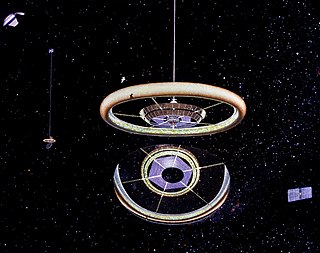
The Stanford torus is a proposed NASA design for a space settlement capable of housing 10,000 to 140,000 permanent residents.
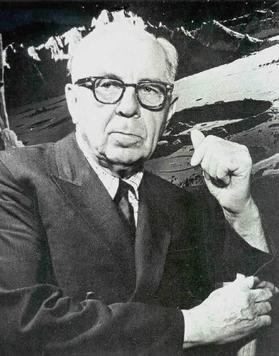
Chesley Knight Bonestell Jr. was an American painter, designer, and illustrator. His paintings inspired the American space program, and they have been influential in science fiction art and illustration. A pioneering creator of astronomical art, along with the French astronomer-artist Lucien Rudaux, Bonestell has been dubbed the "Father of Modern Space art".

The Verein für Raumschiffahrt was a German amateur rocket association prior to World War II that included members outside Germany. The first successful VfR test firing with liquid fuel was conducted by Max Valier at the Heylandt Works on January 25, 1930; and additional rocket experiments were conducted at a farm near Bernstadt, Saxony.

Willy Otto Oskar Ley was a German and American science writer and proponent of cryptozoology. The crater Ley on the far side of the Moon is named in his honor.
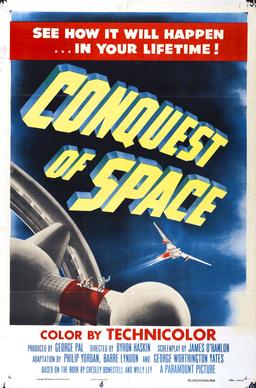
Conquest of Space is a 1955 American Technicolor science fiction film from Paramount Pictures, produced by George Pal, directed by Byron Haskin, that stars Walter Brooke, Eric Fleming, and Mickey Shaughnessy.

Space advocacy is supporting or advocating human activity in outer space. The advocated purposes range from orbital flight, space exploration, commercialization of space and space settlement, to outright space colonization.
Paul D. Spudis (1952–2018) was an American geologist and lunar scientist. His specialty was the study of volcanism and impact processes on the planets, including Mercury and Mars.
"Man in Space" is an episode of the American television series Disneyland which originally aired March 9, 1955 on ABC. It was directed by Disney animator Ward Kimball. This Disneyland episode, was narrated partly by Kimball and also by such scientists Willy Ley, Heinz Haber, and Wernher von Braun, as well as Dick Tufeld of Lost in Space fame.
"Man and the Moon" is an episode of Disneyland, which originally aired on December 28, 1955. It was directed by Disney animator Ward Kimball.

John Cornelius Houbolt was an aerospace engineer credited with leading the team behind the lunar orbit rendezvous (LOR) mission mode, a concept that was used to successfully land humans on the Moon and return them to Earth. This flight path was chosen for the Apollo program in July 1962. The critical decision to use LOR was viewed as vital to ensuring that man reached the Moon by the end of the decade as proposed by President John F. Kennedy. In the process, LOR saved time and billions of dollars by efficiently using the available rocket and spacecraft technologies.
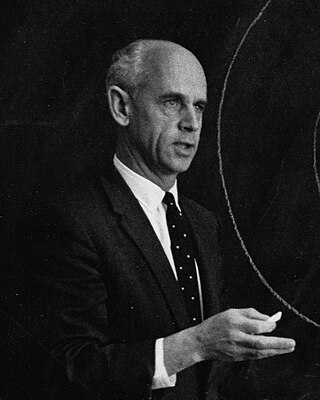
Ernst Stuhlinger was a German-American atomic, electrical, and rocket scientist. After being brought to the United States as part of Operation Paperclip, he developed guidance systems with Wernher von Braun's team for the US Army, and later was a scientist with NASA. He was also instrumental in the development of the ion engine for long-endurance space flight, and a wide variety of scientific experiments.
The 12th World Science Fiction Convention (Worldcon), also known as SFCon, was held on 3–6 September 1954 at the Sir Francis Drake Hotel in San Francisco, California, United States.
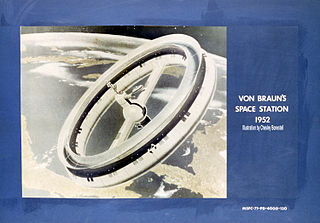
A rotating wheel space station, also known as a von Braun wheel, is a concept for a hypothetical wheel-shaped space station. Originally proposed by Konstantin Tsiolkovsky in 1903, the idea was expanded by Herman Potočnik in 1929, and popularized by Wernher von Braun in 1952.
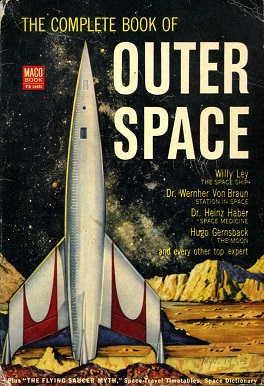
The Complete Book of Outer Space is a 1953 collection of essays about space exploration edited by Jeffrey Logan. It first appeared as a magazine, published by Maco Magazine Corp. The first book publication was by Gnome Press in 1953 in an edition of 3,000 copies.

The Mars Project is a 1952 non-fiction scientific book by the German rocket physicist, astronautics engineer and space architect Wernher von Braun. It was translated from the original German by Henry J. White and first published in English by the University of Illinois Press in 1953.
Helmut Justus Karl Horn was a German-American engineer and applied physicist who was employed at the early Marshall Space Flight Center. Horn worked first at the Peenemünde Army Research Center and later, after the end of World War II, was hired by the U.S. through Operation Paperclip.














